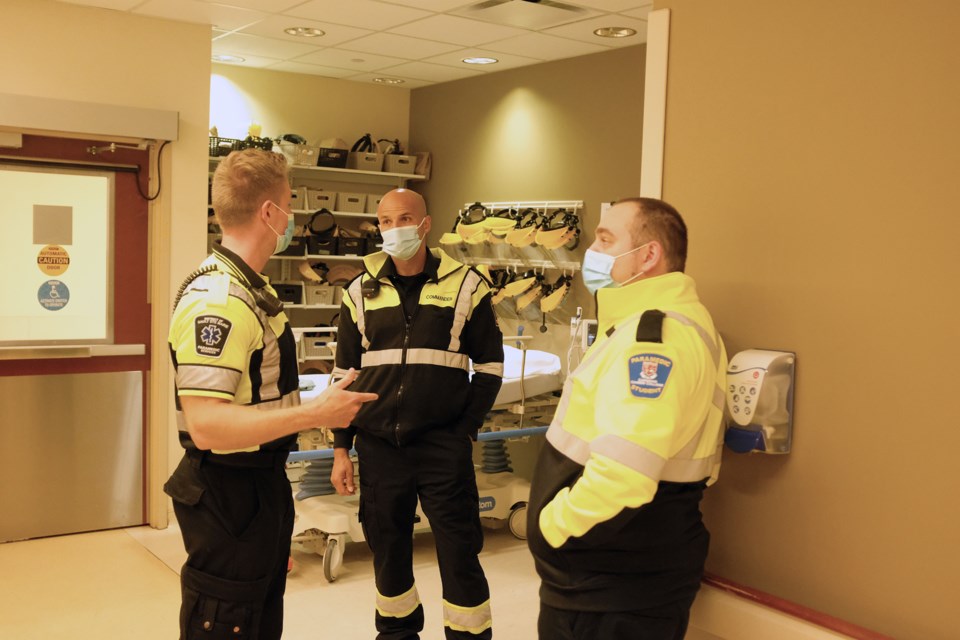Attending his first meeting of the local social services administration board, new board member Sonny Spina offered a solution to the cost of paramedics being delayed while transferring patients to the Emergency Department — bill the hospital.
Ward 1 residents voted for Spina during the recent municipal election and is one of city council’s appointments to the District of Sault Ste. Marie Social Services Administration Board (DSSAB).
On Thursday the DSSAB received the most recent report about paramedic offload delays from the city’s chief of paramedic services Kate Kirkham. She described the problem as one that is being experienced provincewide and something that has been affecting this city long before she became chief in 2021.
Under normal circumstances, Kirkham told the board, a paramedic crew will take a patient to the Emergency Department where a nurse will begin the process of transfer of care.
”Transferring care involves telling them what happened, what treatment was given, and then you pass it off to the emergency department ,” she said. “What has happened over the last few years, and this is provincewide, is paramedic crews are going into the emerg department to do that transfer of care and there is no space for them to put that patient into a room or there might not be staff to take care of that patient, so the paramedic crew are waiting in the hallway with their patients.”
A paramedic crew might wait 45 minutes to transfer a patient or they could be waiting up to 13 hours.
“They do their best, they do a damn good job, to be honest. But it is above their scope and outside of what they can do to give care to that patient and, quite honestly, it’s not fair to the patient,” said Kirkham.
In 2020, local paramedic crews spent a total of 3,889 hours in offload delays, last year that number climbed to over 5,500 hours.
“To put that in perspective you are looking at 15.25 hours per day, per year, you have an ambulance sitting at the hospital,” explained Kirkham.
Spina told Kirkham he was very frustrated when reading her report.
“Not with you, but with these numbers,” he said to Kirkham. “It is not a new trend. It is not sufficient for us to say we have found mitigating strategies when our partners haven’t been doing the same.”
Those hours spent by paramedics in offload delay during 2022, when they could have be available to attend other calls, came at a payroll cost of $656,000. With administrative overhead and other costs, Spina calculated the total cost to the taxpayer comes in close to $1 million.
“One of the mitigating strategies I would like to see is to send that bill back to the hospital,” said Spina. “If these offload delays are [the hospital’s] fault, the city of Sault Ste. Marie’s taxpayers should not be paying for those.”
In response, Kirkham said Sault Area Hospital has been working with the service to improve conditions.
“To be fair, I think they have — especially in the last three months — made significant effort in trying to solve some of these problems. I think the problem is bigger. I think it is much bigger,” she said.
Spina noted another side effect of the offload delays is an increase in the number of Code Red events, described as times when no ambulance is available to respond to an emergency call.
In 2020 there was 825 Code Reds for a total of over 268 hours Sault Ste. Marie had no ambulances available to respond to emergencies. Last year that number increased to 1220 occurrences, with a total of 419 hours, not including data from December.
“Adding more ambulances on the road isn’t going to solve this problem because they are going to be standing in line at the hospital,” said Spina.
DSSAB CEO Mike Nadeau told Spina that despite the worsening statistics, he is optimistic a solution can be found by working together with the hospital.
“I am with you and I love the passion but I think we need a bit more time because we are starting to get someplace and I just don’t want to upset that yet. Just give us until the end of the fiscal to see what we can hammer out because we have a really engaging, honest and frank discussion and they have committed they want to solve it as well,” said Nadeau to Spina.
“I love hearing that, but giving it a bit more time is not something I am open to. It’s been years of this issue,” said Spina in response. “Everybody has to be good partners, as far as I am concerned, to solve this issue. Good patient care is the goal of everybody involved here and we all have to step up to provide it.”
A formal resolution to bill the hospital has not yet been put forward to the board for a vote.
